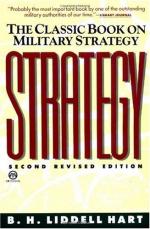
|
| Name: _________________________ | Period: ___________________ |
This test consists of 15 multiple choice questions and 5 short answer questions.
Multiple Choice Questions
1. According to the author, it is critically important to do what to every soldier in a military force?
(a) Maintain their individuality.
(b) Psychologically condition them.
(c) Equip and protect them.
(d) Train them to be leaders.
2. During their first war with Greece, the Persians experienced a revolt in which region?
(a) Libya.
(b) Egypt.
(c) Sicily.
(d) Syria.
3. Prince Edward is credited with improving greatly what type of military element?
(a) Mobile reconnaissance.
(b) Fortified castles.
(c) Combined arms.
(d) Supply trains.
4. What do skilled leaders almost always do when they are at a disadvantage?
(a) Arrange for reinforcements.
(b) Select "picked troops."
(c) Avoid confrontation.
(d) Gather intelligence.
5. What is one problem of relying upon locomotives in warfare?
(a) The civilian population will suffer without access to trains.
(b) Troops suffer health problems.
(c) Coal and labor must be constantly in supply.
(d) The railways must be protected.
6. How does the author define "Grand Strategy"?
(a) The broad strategic military movement of forces.
(b) The organization of mass military forces.
(c) The policies that govern or closely relate to Generalship.
(d) The attack and defense of large regions.
7. During William of Normandy's time, what was the state of military strategy?
(a) It was improving greatly.
(b) It was unpopular for being unchivalrous.
(c) It was in decline.
(d) It was almost totally forgotten.
8. When did the decisive battles of William of Normandy occur?
(a) 1408 AD.
(b) 560 AD.
(c) 1346 AD.
(d) 1066 AD.
9. How did Caesar achieve relatively bloodless victories?
(a) By providing better weapons for his troops.
(b) By attacking supply lines.
(c) By avoiding fortified towns.
(d) By using amphibious assaults.
10. Which of the following was not a major branch of the military during Cromwell's time?
(a) The Navy.
(b) Infantry.
(c) Cavalry.
(d) Artillery.
11. Which country became noted as a major world power for the first time during the First World War?
(a) China.
(b) Russia.
(c) Prussia.
(d) United States of America.
12. In the overall strategic planning for the First World War, what country acted as a buffer between Germany and Russia?
(a) Poland.
(b) Prussia.
(c) France.
(d) Austria.
13. Why did the war chief Vitiges decide not to fight Belisarius in Naples?
(a) He knew Belisarius had superior numbers.
(b) He was afraid of Belisarius and his reputation.
(c) He was already fighting a war in Frankish territories.
(d) He knew the terrain favored the defender too heavily.
14. How were the Greeks able to fend off the Persian's first war against them?
(a) By instituting a draft.
(b) By encouraging Persian colonies to revolt.
(c) By expanding their navy.
(d) By clever negotiation.
15. What events caused France to become a united nation?
(a) The formation of the United States of America.
(b) The country's invasion by foreigners.
(c) The French Revolution.
(d) The politicians and actions by Germany.
Short Answer Questions
1. According to one of the aphorisms introduced at the beginning of the book, what is the likely outcome for all nations that participate in a war?
2. According to the author, how did Turenne's military strategy change as the general aged?
3. According to the author, what nation first employed military strategy in Europe?
4. The Wars of Spanish Succession were strongly affected by what factor in Europe?
5. Who led the second Persian invasion of Greece?
|
This section contains 557 words (approx. 2 pages at 300 words per page) |

|




